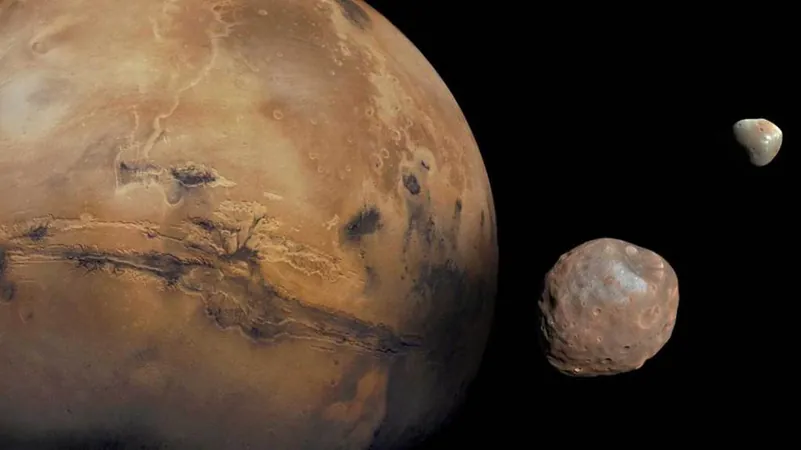
New Study Unravels the Origins of Mars' Captivating Moons, Phobos and Deimos!
2024-11-24
Author: Daniel
A Groundbreaking Study by NASA Scientists
A groundbreaking study by a team of NASA scientists has shed light on the mysterious origins of Mars' two distinct moons, Phobos and Deimos. For over a century since their discovery in 1877, researchers have speculated about how these rugged celestial bodies came to orbit the Red Planet. Now, advanced supercomputer simulations have brought forth an innovative theory that could redefine our understanding of moon formation in the solar system.
The New Theory
Under the leadership of researcher Jacob Kegerreis, the team utilized cutting-edge simulations to explore the possibility that a rogue asteroid once passed perilously close to Mars. This close encounter would have unleashed the asteroid's destruction due to Mars’ strong gravitational forces, resulting in an explosion of rocky fragments scattering in the planet's vicinity.
While a substantial portion of the debris was expelled away into space, some fragments remained trapped in Mars' orbit. Over time, these particles collided and merged, giving rise to the moons we recognize today. The study reveals that the sufficient raw materials generated from the asteroid's destruction can indeed produce moons with characteristics similar to Phobos and Deimos.
Insights from the Researchers
“Our findings provide an exhilarating alternative explanation for the genesis of Phobos and Deimos, the only moons in our solar system that orbit a rocky planet, aside from Earth's moon,” exclaimed Kegerreis, who is a postdoctoral research scientist at NASA’s Ames Research Center in California.
Challenging Prevailing Theories
Interestingly, their findings diverge from the two prevailing theories regarding the moons' origins. The first posits that Phobos and Deimos were once asteroids that were captured by Mars’ gravity. The second theory suggests that a massive impact on Mars sent debris into orbit, eventually coalescing into the moons. However, the latter theory struggles to explain Deimos' distant orbit — a challenge that Kegerreis and his team have tackled head-on.
The researchers' simulations account for Deimos' significant orbital radius, suggesting that a smaller, progenitor asteroid could have efficiently provided the necessary materials to form both moons at their current distances. “Our model enhances the distribution of materials to the outer disk, demonstrating that a smaller asteroid could still generate the building blocks of the moons far from Mars,” co-author Jack Lissauer noted.
Broader Implications
What’s more, the implications of this research extend beyond Mars. The simulation techniques used by Kegerreis and his colleagues could help scientists decipher the formation processes of moons across our solar system and enhance our comprehension of early solar system dynamics, including the encounters of planets, asteroids, and comets.
Looking Ahead to the MMX Mission
Looking ahead, Kegerreis and his team are poised to refine their models, ultimately aiming to illuminate the entire timeline of moon formation around Mars and inspire further predictions regarding the upcoming Martian Moons Exploration (MMX) mission led by JAXA. Scheduled for launch in 2026, the MMX mission seeks to delve into the composition and characteristics of Phobos and Deimos, and even collect surface samples from Phobos to send back to Earth for analysis.
As we eagerly await what discoveries the MMX mission will yield, the new research provides an exciting stepping stone to understanding not just Mars, but the complex histories of other celestial bodies in our cosmic neighborhood. The saga of Phobos and Deimos continues to unfold, and we are just beginning to scratch the surface of secrets that lie in the shadows of Mars!

 Brasil (PT)
Brasil (PT)
 Canada (EN)
Canada (EN)
 Chile (ES)
Chile (ES)
 España (ES)
España (ES)
 France (FR)
France (FR)
 Hong Kong (EN)
Hong Kong (EN)
 Italia (IT)
Italia (IT)
 日本 (JA)
日本 (JA)
 Magyarország (HU)
Magyarország (HU)
 Norge (NO)
Norge (NO)
 Polska (PL)
Polska (PL)
 Schweiz (DE)
Schweiz (DE)
 Singapore (EN)
Singapore (EN)
 Sverige (SV)
Sverige (SV)
 Suomi (FI)
Suomi (FI)
 Türkiye (TR)
Türkiye (TR)